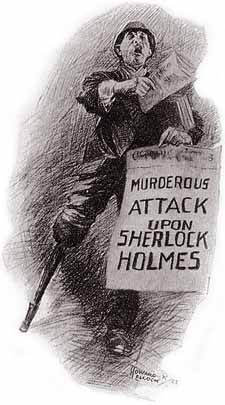An occasional feature about the places in the John H Watson canon
I think I stood stunned for some moments. Then I have a confused recollection of snatching at a paper, of the remonstrance of the man, whom I had not paid, and, finally, of standing in the doorway of a chemist’s shop while I turned up the fateful paragraph. This was how it ran: We learn with regret that Mr Sherlock Holmes, the well-known private detective, was the victim this morning of a murderous assault which has left him in a precarious position. There are no exact details to hand, but the event seems to have occurred about twelve o’clock in Regent Street, outside the Café Royal. The attack was made by two men armed with sticks, and Mr Holmes was beaten about the head and body, receiving injuries which the doctors describe as most serious. He was carried to Charing Cross Hospital, and afterwards insisted upon being taken to his rooms in Baker Street.
‘The Adventure of the Illustrious Client’

Cafe Royal opened at 68 Regent Street in 1865, staying at the same premises right through until it closed down in 2008, serving royalty and celebrities throughout this period. For four years, the property was redeveloped, and the Hotel Cafe Royal now sits on the spot. —londonist.com/2016/04/12-secrets-of-regent-street
Named after the Prince Regent, the street was built in 1819 under the direction of architect John Nash and its Grade II listed facades represent some of the most distinguished architecture in London. When built, Regent Street was the original purpose-built shopping street for the capital. —regentstreetonline.com
This [224–244 Regent Street] was once the site of The Argyll Rooms, a popular entertainment venue owned by the London Philharmonic Society and used for various concerts, public performances and other exhibitions…During a show on 26 December 1832, a young lady was taken home by her friends after appearing to have some kind of fit. The case was recounted in John Ingram’s 1897 book Haunted Homes and Family Traditions of Great Britain, quoting from the diary of Thomas Raikes, who knew the girl. After the young lady got home, she found it difficult to talk, until eventually she told her companions that she had been seized by the vision of a naked male corpse, with its face partly covered by a cloth, though she recognised the corpse of a man she knew. Her friends reassured her that he was okay. The next day, news came through that he in fact had drowned in Southampton after his boat capsized and the body found tangled up in a ‘boat cloak’. —spookyisles.com/soho-haunted-london-ghosts
By the turn of the century Regent Street had enjoyed 80 years as the ‘centre of fashion.’ It was mainly dependent on the custom of society, and out of season it was often almost deserted. But by 1900 a change could be discerned in the nature of the of the Regent Street customer, partly due to a shift in the relative wealth of the aristocracy and middle classes. —The London Encyclopaedia, Edited by Ben Weinreb and Christopher Hibbert, p. 642, Adler & Adler Publishers, Inc., 1986
